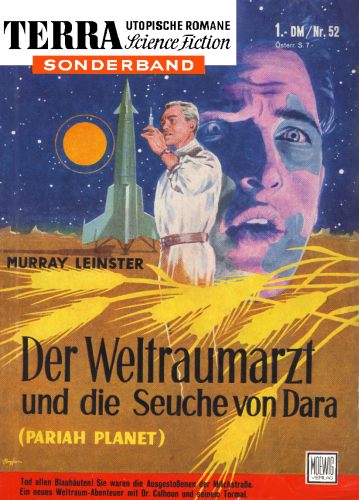Murray Leinster : Der Weltraumarzt und die Seuche von Dara (Pariah Planet)
Terra Sonderband 52, 16.03.1962
Deutsche Erstausgabe
Originalausgabe AMAZING 07/1961
Aus dem Amerikanischen von Horst Mayer
Titelbild : Karl Stephan
Der interstellare Gesundheitsdienst hatte Sternsektor 12 lange nicht überwacht und damit eine gefährliche Situation heraufbeschworen. Dr. Calhoun, der diesen Sektor vertretungsweise übernimmt, erkennt dies sofort, als er sich mit seinem kleinen Inspektionsschiff dem Planeten Weald nähert. "Tod allen Blauhäuten!" dröhnt es ihm aus dem Empfänger entgegen. "Ein typischer Fall von Hysterie", diagnostiziert Dr. Calhoun. Die Frage ist nur: Was kann ein Einzelner tun, um die Bevölkerung eines ganzen Planeten nachhaltig von dieser Hysterie zu befreien ... ?Klappentext
Meinem persönlichem Geschmack nach bisher die beste der Calhoun-Stories um den galaktischen Mediziner und seinen Tormal. Zentrales Thema ist weniger die Krankheit, die den Planeten Dara vor Jahrzehnten heimgesucht hat, sondern die überbordende Hysterie, die in ihrer Absurdität starke faschistische Züge annimmt. Leinster erzählt dies straightforward, die Lösung eines großen Teils des Problems - die Hungersnot auf Dara wird durch die Kaperung von als Getreidesilos dienenden Raumfrachtern gelöst - ist mir allerdings zu wenig real, zu märchenhaft-optimistisch.
Wie ich beim letzten Mal, Band 49, bereits schrieb, gibt es alle Med Service-Geschichten online in der Baen Free Library. Die Herausgeber, Eric Flint und Guy Gordon, haben dazu ein sehr treffendes Nachwort verfasst :
To modern science fiction readers, the "dean of science fiction" is a reference to Robert Heinlein. But the phrase was actually first applied to Murray Leinster, and the unofficial title was one he carried for many years.
There were three reasons he enjoyed that accolade.
The first is simply his longevity as a writer. Leinster's first science fiction story, "The Runaway Skyscraper," was published in Argosy magazine in February of 1919. And he continued to publish science fiction stories for half a century thereafter.
The second reason is that Leinster, to a large degree, set the basic parameters for science fiction. He was the first writer—or, at least, the most important one—to establish such fundamental themes as "first contact" and "alternate history" and a number of other basic story lines in the genre.
In fact, in the stories which are collected in this volume, Med Ship, Leinster established the sub-genre of the "science fiction doctor story." That sub-genre, as with so many others which Leinster created, would be explored and expanded on by later writers. Alan Nourse's Star Surgeon and James White's very popular Sector General series are the direct lineal descendants of these stories—as is the current Stardoc series by S.L. Viehl.
The third reason he was called "the dean of science fiction writers," however, is the most important. Without it, the first two would be of only academic interest. Leinster was one of a handful of early science fiction writers who placed telling a story at the center of the stage, not "illustrating science in fiction." He, probably more than any other writer in the first decades of the twentieth century, transformed science fiction into a real genre of fiction. And that is why his work survives, and why we are re-issuing these volumes.
We began with his Med Ship stories, because those are probably the best known of his works to the modern audience. This edition, for the first time, contains all eight of the stories which Leinster wrote in that setting. In the next volume, Planets of Adventure, we will present more of the best stories which Leinster wrote. As the title suggests, these all have a common theme: adventures on other planets.
It seems a fitting title. By and large, it's fair to say that Leinster created that sub-genre also. Granted, Edgar Rice Burroughs' Barsoom novels were already coming into print when Leinster was still a teenager. But Barsoom, although it claims to be Mars, is not really a planet so much as the setting for a fantasy adventure. Leinster's planets—such as the planet on which Burl struggles against giant mutated insects in The Forgotten Planet, or the ones on which Colonial Survey Officer Bordman has his adventures—are those of a science fiction writer, not a fantasist.
In truth, it's hard to think of any branch of science fiction which Murray Leinster didn't pioneer. And write wonderfully entertaining stories in the process.
Think of him as "the dean of science fiction emeritus," if you wish. Or simply, as we do, as one of science fiction's all-time greatest story-tellers.
Ich kann den beiden da nur zustimmen. Und werde mich demnächst einmal nach den Stardoc-Geschichten von S. L. Viehl umsehen, ein Vergleich ist da sicher interessant. Falls die irgendjemand kennt, wäre ich für einen Kommentar dankbar.
"Pariah Planet" kam auch in 1961 als Buchausgabe unter dem Titel "This World is Taboo" überarbeitet in einer Extended Version bei ACE heraus. Bei gutenberg.org findet man beide Ausgaben. Wer sich das Ganze vorlesen lassen will, der sei auf das Hörbuch von LibriVox verwiesen.
TERRA SF inside - Autorenportrait Murray Leinster
TERRA Sonderband 49 - Murray Leinster : Der Weltraumarzt
TERRA Sonderband 52 - Murray Leinster : Der Weltraumarzt und die Seuche von Dara
TERRA SF 468 - Murray Leinster : Der Weltraumarzt greift ein

Keine Kommentare:
Kommentar veröffentlichen